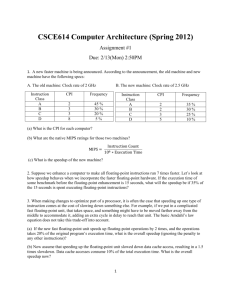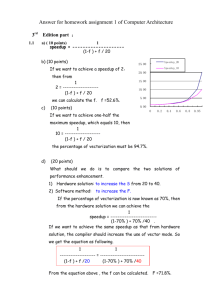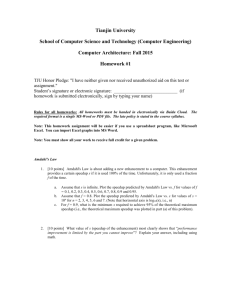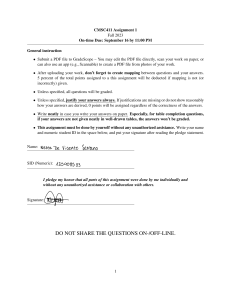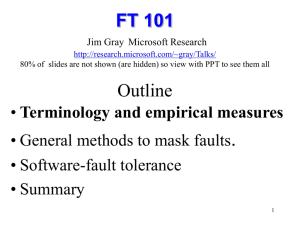Solution - Abandah
advertisement
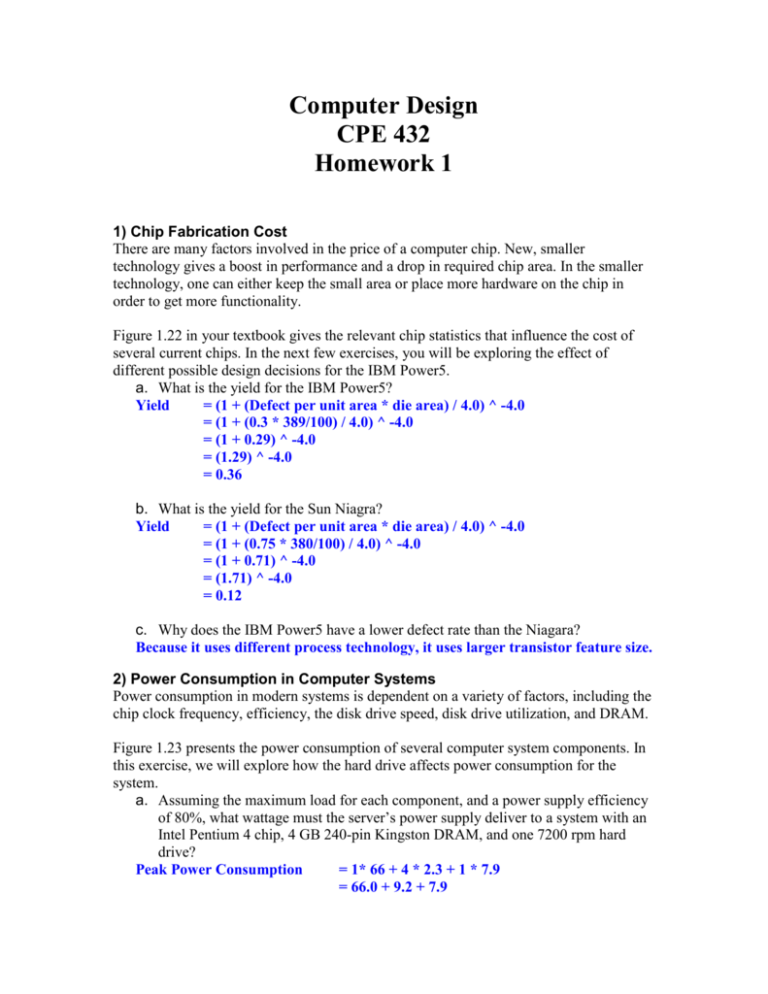
Computer Design CPE 432 Homework 1 1) Chip Fabrication Cost There are many factors involved in the price of a computer chip. New, smaller technology gives a boost in performance and a drop in required chip area. In the smaller technology, one can either keep the small area or place more hardware on the chip in order to get more functionality. Figure 1.22 in your textbook gives the relevant chip statistics that influence the cost of several current chips. In the next few exercises, you will be exploring the effect of different possible design decisions for the IBM Power5. a. What is the yield for the IBM Power5? Yield = (1 + (Defect per unit area * die area) / 4.0) ^ -4.0 = (1 + (0.3 * 389/100) / 4.0) ^ -4.0 = (1 + 0.29) ^ -4.0 = (1.29) ^ -4.0 = 0.36 b. What is the yield for the Sun Niagra? Yield = (1 + (Defect per unit area * die area) / 4.0) ^ -4.0 = (1 + (0.75 * 380/100) / 4.0) ^ -4.0 = (1 + 0.71) ^ -4.0 = (1.71) ^ -4.0 = 0.12 c. Why does the IBM Power5 have a lower defect rate than the Niagara? Because it uses different process technology, it uses larger transistor feature size. 2) Power Consumption in Computer Systems Power consumption in modern systems is dependent on a variety of factors, including the chip clock frequency, efficiency, the disk drive speed, disk drive utilization, and DRAM. Figure 1.23 presents the power consumption of several computer system components. In this exercise, we will explore how the hard drive affects power consumption for the system. a. Assuming the maximum load for each component, and a power supply efficiency of 80%, what wattage must the server’s power supply deliver to a system with an Intel Pentium 4 chip, 4 GB 240-pin Kingston DRAM, and one 7200 rpm hard drive? Peak Power Consumption = 1* 66 + 4 * 2.3 + 1 * 7.9 = 66.0 + 9.2 + 7.9 = 83.1 W Power Supply Wattage = 83.1 / 0.8 = 103.9 W b. How much power will the 7200 rpm disk drive consume if it is idle roughly 50% of the time? HD Power Consumption = 0.5 * 7.9 + 0.5 * 2.9 = 5.4 W c. Given that the time to read data off a 7200 rpm disk drive will be roughly 75% of a 5400 rpm disk, at what idle time of the 7200 rpm disk will the power consumption be equal, on average, for the two disks? Let the 7200-disk busy time = x 7200-disk power 4.0 * (1-x) + 7.9 * x 4.0 + 3.9 x 1.1 = 5400-disk power = 2.9 * (1-x/0.75) + 7.0 * x/0.75 = 2.9 – 3.87 x + 9.33 x = 5.47 x – 3.9 x Hence x = 0.70 Idle time = 1.0 – 0.70 = 0.30 3) The Cost of Reliability (and Failure) in Web Servers Exercises 3 and 4 deal with the cost of not having reliable Web servers. The data is in two sets: one gives various statistics for Gap.com, which was down for maintenance for two weeks in 2005 [AP 2005]. The other is for Amazon.com, which was not down, but has better statistics on high-load sales days. The exercises combine the two data sets and require estimating the economic cost to the shutdown. The main reliability measure is MTTF. We will now look at different systems and how design decisions affect their reliability. Refer to Figure 1.25 for company statistics. a. We have a single processor with an FIT of 200. What is the MTTF for this system? MTTF = 10^9 / 200 = = 5 * 10^6 b. If it takes two days to get the system running again, what is the availability of the system? Availability = MTTF / ( MTTF + MTTR) = 5 * 10^6 / (5 * 10^6 + 48) = 99.999% 4) The Cost of Reliability (and Failure) in Web Servers Imagine that the government, to cut costs, is going to build a supercomputer out of the cheap processor system in Exercise 3 above rather than a special purpose reliable system. What is the MTTF for a system with 100 processors? Assume that if one fails, they all fail. FIT = 100 * 200 = 20,000 MTTF = 10^9 / 20,000 = 5 * 10^4 5) Performance Your company has just bought a new dual Pentium processor, and you have been tasked with optimizing your software for this processor. You will run two applications on this dual Pentium, but the resource requirements are not equal. The first application needs 75% of the resources, and the other only 25% of the resources. a. Given that 60% of the first application is parallelizable, how much speedup would you achieve with that application if run in isolation? Speedup = 1 / ((1-f) + f/s) = 1 / ((1-0.6) + 0.6/2) = 1 / (0.4 + 0.3) = 1.43 b. Given that 95% of the second application is parallelizable, how much speedup would this application observe if run in isolation? Speedup = 1 / ((1-f) + f/s) = 1 / ((1-095) + 0.95/2) = 1 / (0.05 + 0.475) = 1.90 c. Given that 60% of the first application is parallelizable, how much overall system speedup would you observe if you parallelized it, but not the second application? System Speedup = 1 / ((1-f) + f/s) = 1 / (0.25 + 0.75/1.43) = 1 / (0.25 + 0.52) = 1.29 d. How much overall system speedup would you achieve if you parallelized both applications, given the information in parts (a) and (b)? System Speedup = 1 / ((1-f) + f/s) = 1 / (0.75 + 0.25/1.9) = 1 / (0.75 + 0.13) = 1.13 6) Addressing Modes Show how to implement the addressing modes in Figure B.6 using the first three addressing modes. - Register indirect: add r4, (r1) add r4, 0(r1) - Indexed: add r3, (r1,r2) add r1, r2 add r3, 0(r1) add r1, 1001(r0) lw r3, 0(r3) add r1, 0(r3) - Auto increment: add r1, (r2)+ add r1, 0(r2) addi r2, 4 - Auto decrement: add r1, -(r2) addi r2, -4 add r1, 0(r2) - Direct: add r1, (1001) - Memory indirect: add r1, @(r3) - Scaled: add r1, 100(r2)[r3] muli r3, 4 add r2, r3 add r1, 100(r2) 7) ISA Classes Write code sequences to implement D=(A+B)-(C+D); on the four ISA classes. - Stack: push A push B add push C push D add sub pop D - Accumulator: lw A add B sub C sub D sw D - Register-Memory: lw r1, A add r1, B sub r1, C sub r1, D sw r1, D - Register-Register: lw r1, A lw r2, B add r1, r2 lw r2, C sub r1, r2 lw r2, D sub r1, r2 sw r1, D 8) Five-stage Pipeline Using pipeline diagrams, find how many cycles are needed to execute the following code sequence. a. When stalls are used to solve hazards and branch instructions are resolved in the Execute stage. b. When full forwarding paths are used plus stalls (when needed), one branch delay slot, and branch instructions are resolved in the Decode stage. add lw sw beq andi skip: sw r2, r1, r1, r4, r3, r1, r5, r6 0(r2) 4(r2) r4, skip r3, 0 8(r2) r2, r1, r1, r4, r3, r1, 1 2 3 r5, r6 F D E 0(r2) F D 4(r2) F r4, skip r3, 0 8(r2) (a) add lw sw beq andi skip: sw 4 M - 1 1 5 6 7 8 9 0 1 W - E M W - D - - E M W F - - D E M F - n F 1 1 1 1 1 1 2 3 4 5 6 7 W n n n D E M W Execution takes 15 cycles. (a) add lw sw beq andi skip: sw r2, r1, r1, r4, r3, r1, 1 2 3 r5, r6 F D E 0(r2) F D 4(r2) F r4, skip r3, 0 8(r2) Execution takes 10 cycles. 4 M E D F 5 W M E D F 1 1 1 1 1 1 1 1 6 7 8 9 0 1 2 3 4 5 6 7 W M E D F W M W E M W D E M W
